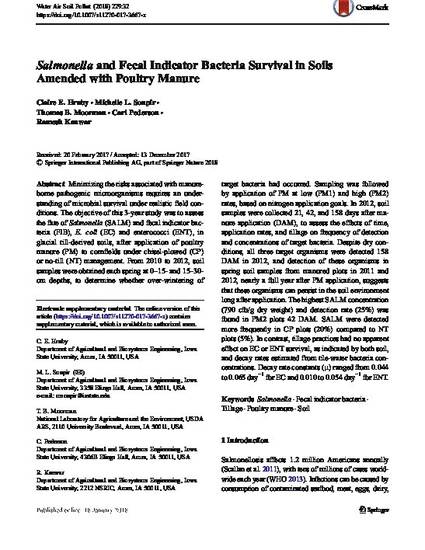
Minimizing the risks associated with manure-borne pathogenic microorganisms requires an understanding of microbial survival under realistic field conditions. The objective of this 3-year study was to assess the fate of Salmonella (SALM) and fecal indicator bacteria (FIB), E. coli (EC) and enterococci (ENT), in glacial till-derived soils, after application of poultry manure (PM) to cornfields under chisel-plowed (CP) or no-till (NT) management. From 2010 to 2012, soil samples were obtained each spring at 0–15- and 15–30-cm depths, to determine whether over-wintering of target bacteria had occurred. Sampling was followed by application of PM at low (PM1) and high (PM2) rates, based on nitrogen application goals. In 2012, soil samples were collected 21, 42, and 158 days after manure application (DAM), to assess the effects of time, application rates, and tillage on frequency of detection and concentrations of target bacteria. Despite dry conditions, all three target organisms were detected 158 DAM in 2012, and detection of these organisms in spring soil samples from manured plots in 2011 and 2012, nearly a full year after PM application, suggests that these organisms can persist in the soil environment long after application. The highest SALM concentration (790 cfu/g dry weight) and detection rate (25%) was found in PM2 plots 42 DAM. SALM were detected more frequently in CP plots (20%) compared to NT plots (5%). In contrast, tillage practices had no apparent effect on EC or ENT survival, as indicated by both soil, and decay rates estimated from tile-water bacteria concentrations. Decay rate constants (μ) ranged from 0.044 to 0.065 day−1 for EC and 0.010 to 0.054 day−1 for ENT.
Available at: http://works.bepress.com/michelle_soupir/67/

This article is published as Hruby, Claire E., Michelle L. Soupir, Thomas B. Moorman, Carl Pederson, and Ramesh Kanwar. "Salmonella and Fecal Indicator Bacteria Survival in Soils Amended with Poultry Manure." Water, Air, & Soil Pollution 229, no. 2 (2018): 32. doi: 10.1007/s11270-017-3667-z. Posted with permission.